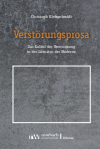Zusammenfassung
Das Paradigma der Verstörung ist ein wirkmächtiges, bisher unerforschtes Kalkül der literarischen Moderne. Anhand von Einzelanalysen deutschsprachiger Prosa von der Romantik bis zur Gegenwart (Tieck, Droste-Hülshoff, Büchner, Kafka, Aichinger, Kracht u.a.) geht die Studie dieser Strategie der Verstrickung nach und versucht, literaturtheoretisch eine Perspektive jenseits der Alternative von Hermeneutik und Dekonstruktion zu eröffnen. Der Begriff der literarischen Verstörung setzt sich in entscheidender Weise von bisherigen Konzepten der Störungsforschung ab, weil er weder rein negativ konnotiert ist noch eine Auflösung ins Positive beinhaltet, sondern genau in der Mitte dieser beiden Pole verortet ist als ein anhaltender Zustand des Zweifelns.
Abstract
The paradigm of disturbance is a powerful and, to date, unexplored mode of literary modernism. Through individual analyses of selected German-language prose from the Romantic period to the present (Tieck, Droste-Hülshoff, Büchner, Kafka, Aichinger, Kracht, and others), this study examines this strategy of entanglement and attempts to open up a perspective beyond the alternative of hermeneutics and deconstruction in terms of literary theory. The concept of literary disturbance used in the work sets itself apart from previous concepts of disruption research in a decisive way because it neither has a purely negative connotation nor contains a positive resolution, but is located exactly in the middle of these two poles as a persistent state of doubt.
Schlagworte
Affekt Emotionsforschung Gewalt Rezeptionsästhetik Unverständlichkeit Unverständnis Verunsicherung Wahn Wirkung Clemens Setz Christian Kracht Rainald Goetz Thomas Bernhard Ilse Aichinger Hans Henny Jahn Franz Kafka Jeremias Gotthelf Annette von Droste-Hülshoff Georg Büchner Ludwig Tieck Narrative Anomalien Negative Ästhetik Dekonstruktion Hermeneutik Literarische Moderne- Kapitel Ausklappen | EinklappenSeiten
- 9–26 1. Einleitung 9–26
- 87–180 3. Expliziter Modus 87–180
- 181–262 4. Subtiler Modus 181–262
- 263–344 5. Aggressiver Modus 263–344
- 355–382 7. Literaturverzeichnis 355–382

